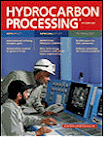Monday, August 23, 2010
Recommended :
- Subscribes to FREE Hydrocarbon Processing
- Tips on Succession in FREE Subscription
 Liquefied Petroleum Gas (LPG) contains mainly Propane (C3) and Butane (i-C4 & n-C4), Liquid Ethylene (C2=) and Liquefied Natural Gas (LNG) contains mainly Methane will evaporate at ambient condition e.g. 20 degC @ 101.325 kPag.
Liquefied Petroleum Gas (LPG) contains mainly Propane (C3) and Butane (i-C4 & n-C4), Liquid Ethylene (C2=) and Liquefied Natural Gas (LNG) contains mainly Methane will evaporate at ambient condition e.g. 20 degC @ 101.325 kPag.
LPG, Liquid Ethylene and LNG can be stored in refrigerated vessel at its bubble point and atmospheric pressure. Their bubble point can be as low as -40, -104 and -162 degC are commonly known as cryogenic temperature and fluid as cryogenic fluid.
- Subscribes to FREE Hydrocarbon Processing
- Tips on Succession in FREE Subscription
LPG, Liquid Ethylene and LNG can be stored in refrigerated vessel at its bubble point and atmospheric pressure. Their bubble point can be as low as -40, -104 and -162 degC are commonly known as cryogenic temperature and fluid as cryogenic fluid.
Heat leaks into the cryogenic fluid will results vaporization and lead to Boil-Off-Gas (BOG) generation. Other than heat leak, there are other scenarios can lead to BOG generation :
- vaporized vapor due to barometric pressure decrease
- vaporized vapor due to ambient temperature increase
- cryogenic fluid rundown piping
- cryogenic fluid circulation / loading line
- ship / truck loading arm
- cryogenic fluid storage tank
- cryogenic fluid rundown pump
- cryogenic fluid in-tank pump
- flashed non-condensable gasses
- negative Joule-Thompson effect
- "hot" rundown LNG into "cold" LNG
- cooling of loading arm
- cooling of ship / truck
Vaporized vapor due to barometric pressure decrease & ambient temperature increase
Environment pressure and temperature change affects BOG generation. Maximum BOG generation during summer, noon and high elevation (with low barometric pressure). On the other hand, minimum BOG generation during winter, mid-night and near sea side (high barometric pressure).
Heat leaks into Cryogenic fluid rundown piping, circulation / loading line, ship / truck loading arm & storage tank
Ambient heat leaks cryogenic fluid will be limited by insulation layer. Heat leaks into subjects to insulation thickness, thermal conductivity, installation quality, etc. Higher insulation thickness, lower thermal conductivity, high installation quality and etc maintain good heat insulation and reduce BOG generation.
Heat generated by rundown pump & in-tank pumpand leaks into Cryogenic fluid
Pumps is required for transferring cryogenic liquid from production plant to storage tank and from storage tank to ship/truck. Pump will absorb power to move cryogenic fluid and any deficiency will generate heat and it will transfer into cryogenic fluid. Pump heat leaks subject to pump capacity, develop head and efficiency. Larger pump, higher head and lower efficiency lead to excess heat generation and leaks into cryogenic fluid.
Flashing of non-condensable gasses
Present of inert / non-condensable gasses such as nitrogen, carbon monoxide in cryogenic fluid may flash in the storage tank.
Negative Joule-Thompson effect
Another phenomenon is negative Joule Thompson (negative JT) where pressure decrease in rundown line lead to higher temperature. Typical gas is Hydrogen.
"Hot" rundown into "cold" cryogenic fluid
Hot cryogenic fluid from one train with hotter temperature which carries heat and rundown into cryogenic tank with colder temperature can results vaporization.
Hot cryogenic fluid from one train with hotter temperature which carries heat and rundown into cryogenic tank with colder temperature can results vaporization.
Cooling of loading arm & tank in ship / truck
Loading arm is heated to ambient temperature when it is unrest for long time. Cryogenic tank in ship / truck is heated by ambient when it is returned with empty tank. All loading arm and tank in ship/truck will needs cooling prior to storage. Large amount of BOG is generated during cooling time.Coming topic will discuss quick way to estimate BOG rate.
Related Topics
Labels: gas processing, LNG
0 Comments:
Post a Comment
Let us know your opinion !!! You can use some HTML tags, such as <b>, <i>, <a>
Subscribe to Post Comments [Atom]
Home:
<< Home